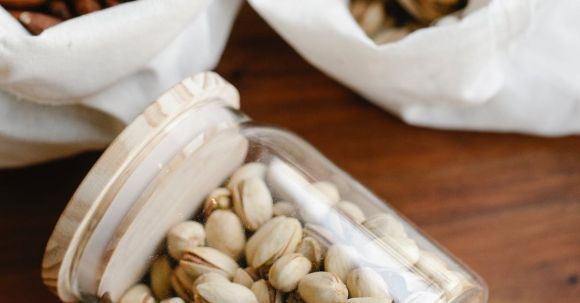The popularity of plant-based diets has been growing steadily in recent years, with more and more people choosing to adopt a vegetarian lifestyle. One concern that often comes up when discussing vegetarianism is the question of protein. Many people believe that it is difficult for vegetarians to get enough protein in their diet without consuming animal products. However, this is simply not true. There are plenty of plant-based protein sources that can provide all the essential amino acids that the body needs. In this article, we will explore some of the best plant-based protein sources for vegetarians.
Author: fit-on
Have you ever hit a wall in your fitness journey? You're working hard, putting in the effort, but suddenly your progress stalls. This frustrating phenomenon is known as an exercise plateau, and it's a common roadblock that many people face along their fitness journey. The good news is that there are strategies you can implement to overcome exercise plateaus and continue making progress towards your goals. In this article, we will explore effective ways to break through plateaus and keep your fitness journey on track.
Evaluate Your Routine
The first step in overcoming an exercise plateau is to evaluate your current routine. Take a close look at your workouts and assess if there are any areas that may be hindering your progress. Are you doing the same exercises with the same weights week after week? Are you following a consistent routine without any variation? If so, it may be time to shake things up.Switch Up Your Routine
One of the most effective ways to overcome an exercise plateau is to introduce variety into your workouts. Your body adapts to the stress you place on it, so if you're doing the same exercises repeatedly, your progress will stagnate. Try incorporating new exercises, changing the order of your workouts, or increasing the intensity. By challenging your body in new ways, you can break through plateaus and stimulate further growth.Increase the Intensity
If you've been doing the same workouts with the same intensity for a while, it may be time to push yourself harder. Increasing the intensity of your workouts can help you overcome plateaus and continue making progress. This can be done by lifting heavier weights, increasing the number of repetitions or sets, or shortening your rest periods. Just be sure to listen to your body and gradually increase the intensity to avoid injury.Try Different Training Methods
Another effective strategy to overcome exercise plateaus is to try different training methods. If you've been primarily doing weightlifting, consider incorporating cardiovascular exercises like running or cycling into your routine. If you've been focusing on high-intensity interval training, try adding in some yoga or Pilates. By diversifying your training methods, you can challenge your body in new ways and break through plateaus.Prioritize Recovery
Sometimes, plateaus occur because your body is not getting enough time to recover and repair. Overtraining can lead to fatigue, decreased performance, and a halt in progress. Prioritizing recovery is crucial to overcome exercise plateaus. Make sure you're getting enough sleep, fueling your body with nutritious food, and taking rest days. Incorporating active recovery activities like yoga or foam rolling can also aid in recovery and help you overcome plateaus.Stay Consistent
Consistency is key when it comes to overcoming exercise plateaus. It's important to stay committed to your fitness routine and not get discouraged by temporary setbacks. Plateaus are a natural part of the fitness journey, and by staying consistent and focused, you can push through them and continue making progress towards your goals.In conclusion
Exercise plateaus are a common roadblock along the fitness journey, but they don't have to derail your progress. By evaluating your routine, introducing variety, increasing the intensity, trying different training methods, prioritizing recovery, and staying consistent, you can overcome plateaus and continue moving forward. Remember, progress takes time and patience, so trust the process and keep pushing towards your goals.
Losing weight is often a challenge, but the real test lies in keeping it off. Many people struggle with the yo-yo effect of losing weight only to regain it shortly after. However, with the right approach and mindset, it is possible to shed those unwanted pounds and maintain a healthy weight in the long run. In this article, we will explore effective strategies to help you lose weight and keep it off.
1. Set Realistic Goals
The first step to successful weight loss is setting realistic goals. It's important to remember that losing weight takes time and effort. Instead of aiming for a drastic transformation, focus on achieving a healthy and sustainable weight loss of 1-2 pounds per week. By setting achievable goals, you'll be more likely to stay motivated and stick to your weight loss journey.2. Make Healthy Dietary Changes
A balanced and nutritious diet is crucial for sustainable weight loss. Instead of resorting to fad diets or extreme calorie restrictions, opt for a well-rounded eating plan that includes a variety of fruits, vegetables, lean proteins, whole grains, and healthy fats. Be mindful of portion sizes and practice mindful eating to avoid overindulgence. Remember, it's not about depriving yourself, but rather making healthier choices and finding a sustainable balance.3. Incorporate Regular Exercise
Physical activity plays a vital role in weight loss and weight maintenance. Aim for at least 150 minutes of moderate-intensity aerobic exercise or 75 minutes of vigorous-intensity aerobic exercise per week. Additionally, include strength training exercises at least twice a week to improve muscle tone and boost metabolism. Find activities you enjoy, whether it's dancing, swimming, or hiking, as this will increase your chances of sticking to a regular exercise routine.4. Stay Hydrated
Drinking enough water is often overlooked but is essential for weight loss success. Water helps to flush out toxins, aids digestion, and helps you feel fuller, reducing the chances of overeating. Aim to drink at least 8 cups of water per day and consider replacing sugary beverages with water or herbal tea. Additionally, staying hydrated can boost your energy levels, making it easier to stay active and motivated.5. Get Sufficient Sleep
Many people underestimate the importance of quality sleep when it comes to weight loss. Lack of sleep can disrupt hormonal balance, leading to increased appetite and cravings for unhealthy foods. Aim for 7-9 hours of uninterrupted sleep per night to support your weight loss efforts. Establish a regular sleep routine, create a sleep-friendly environment, and avoid stimulating activities before bedtime.6. Manage Stress
Stress can sabotage weight loss efforts by triggering emotional eating and hormonal imbalances. Find healthy ways to manage stress, such as practicing yoga, meditation, or engaging in hobbies that bring you joy. Prioritize self-care and make time for activities that help you relax and unwind. By effectively managing stress, you'll be better equipped to make mindful food choices and maintain a healthy weight.7. Seek Support
Weight loss can be challenging, but you don't have to go through it alone. Seek support from friends, family, or join a weight loss community to stay motivated and accountable. Surround yourself with individuals who share similar goals and can provide encouragement and guidance along the way. In conclusion, losing weight and keeping it off is a journey that requires dedication, patience, and a holistic approach. By setting realistic goals, making healthy dietary changes, incorporating regular exercise, staying hydrated, getting sufficient sleep, managing stress, and seeking support, you can achieve sustainable weight loss and enjoy long-term success. Remember, it's not a quick fix, but a lifestyle change that will ultimately lead to a healthier and happier you.
In recent years, there has been a growing interest in organic food. Many people believe that it is healthier, more sustainable, and better for the environment. But is this really the case? In this article, we will explore the truth about organic food and separate fact from fiction.
What is Organic Food?
Organic food refers to crops and livestock that are grown or raised without the use of synthetic pesticides, fertilizers, antibiotics, or hormones. Instead, organic farmers rely on natural methods such as crop rotation, composting, and biological pest control to maintain soil fertility and control pests. Organic livestock are raised on organically grown feed and have access to outdoor areas.Health Benefits
One of the main reasons people choose organic food is because they believe it is healthier. However, scientific evidence on the health benefits of organic food is still limited. While some studies have found that organic food may contain higher levels of certain nutrients, such as antioxidants, others have shown no significant difference. It is important to note that the nutritional content of food can vary depending on several factors, including soil quality and farming practices.Pesticide Residues
Another argument in favor of organic food is the reduced exposure to pesticide residues. It is true that organic crops are grown without synthetic pesticides, which can leave residues on conventionally grown produce. However, it is important to note that the levels of pesticide residues found in conventionally grown food are generally well below the safety limits set by regulatory agencies. Washing and peeling fruits and vegetables can further reduce any potential exposure.Environmental Impact
Organic farming is often touted as being more sustainable and better for the environment. Organic practices aim to promote biodiversity, conserve water and soil, and reduce pollution. However, organic farming also has its drawbacks. Organic crops can require more land and resources to produce the same yield as conventional crops. Additionally, some organic pesticides can have negative effects on non-target species and the environment.Cost and Accessibility
One of the main challenges with organic food is its cost. Organic products are often more expensive than conventional counterparts due to the higher costs associated with organic farming practices. This can make organic food less accessible to lower-income individuals and families. However, the growing demand for organic food has led to increased availability and affordability in some areas.The Importance of Labels
When shopping for organic food, it is important to look for the appropriate labels. In the United States, the USDA Organic seal ensures that a product has been certified organic by a USDA-accredited certifying agent. This certification process involves meeting strict standards for organic production and handling. However, it is worth noting that not all organic products will carry the USDA Organic seal, especially for small-scale farmers who may not have the resources for certification.Making Informed Choices
In conclusion, the truth about organic food is complex. While organic farming practices can have environmental benefits and may reduce exposure to pesticide residues, the health benefits of organic food are still debated. It is important for consumers to make informed choices based on their personal values and priorities. Whether you choose organic or conventional, a diet rich in fruits, vegetables, whole grains, and lean proteins is key to a healthy lifestyle.
Athletes are constantly looking for ways to improve their performance and gain an edge over the competition. One effective method to achieve these goals is by incorporating sports-specific workouts into their training routine. These workouts are specifically designed to target the muscles and movements required in a particular sport, helping athletes to enhance their skills and abilities on the field or court. In this article, we will explore the benefits of sports-specific workouts and provide some examples for different sports.
Benefits of Sports-specific Workouts
Sports-specific workouts offer several benefits for athletes. Firstly, they help to improve the overall performance by targeting the specific muscle groups and movements involved in a particular sport. This targeted approach allows athletes to develop the strength, speed, agility, and endurance required for their sport, leading to better performance and reduced risk of injury. Secondly, sports-specific workouts help to enhance the athlete's skills and abilities related to their sport. By replicating the movements and demands of the sport in their training, athletes can improve their technique, timing, and coordination. This translates to better performance during game situations, as the body becomes more efficient and familiar with the required movements. Lastly, sports-specific workouts can also have a positive impact on an athlete's mental game. By training in a manner that closely resembles the demands of their sport, athletes can build confidence and mental resilience. This mental preparation can be just as crucial as physical training when it comes to performing under pressure and making split-second decisions on the field.Sports-specific Workouts for Different Sports
Now, let's take a look at some examples of sports-specific workouts for different sports: Basketball: To improve vertical jump and explosiveness, basketball players can incorporate exercises like jump squats, box jumps, and depth jumps into their training routine. These exercises target the leg muscles and help to develop the power needed for jumps and sprints on the court. Soccer: Soccer players can benefit from workouts that focus on improving speed, agility, and endurance. Cone drills, ladder drills, and shuttle runs are excellent choices for soccer-specific training. These exercises simulate the quick changes of direction, acceleration, and deceleration movements required in a soccer match. Tennis: To enhance rotational power and core stability, tennis players can include exercises like medicine ball twists, Russian twists, and planks in their workouts. These exercises target the muscles of the core, which are essential for generating power in shots and maintaining stability during quick movements on the court. Swimming: For swimmers, workouts that improve upper body strength and endurance are crucial. Pull-ups, push-ups, and resistance band exercises can help to develop the muscles of the back, shoulders, and arms, enabling swimmers to generate more power and maintain a strong stroke throughout their races.Conclusion
Sports-specific workouts are a valuable tool for athletes looking to take their performance to the next level. By targeting the specific muscles and movements required in their sport, athletes can enhance their skills, improve their physical capabilities, and build mental resilience. Whether you're a basketball player, soccer player, tennis player, or swimmer, incorporating sports-specific workouts into your training routine can provide you with the edge you need to excel in your chosen sport. So, lace up your shoes, grab your racket, or dive into the pool, and start training like a pro today!
Losing weight can be a challenging journey, both physically and mentally. It requires dedication, commitment, and most importantly, finding your inner strength. At our weight loss programs, we understand the struggles and obstacles that come with shedding those extra pounds. We are here to support you every step of the way, helping you tap into your inner strength to achieve your weight loss goals.
Understanding the Importance of Inner Strength
Before we dive into how our weight loss programs can help you find your inner strength, let's first understand why it is so crucial in your weight loss journey. Inner strength is the mental and emotional resilience that allows you to overcome obstacles and stay motivated, even when faced with challenges. Without inner strength, it can be easy to give in to temptations, lose motivation, or become overwhelmed by the process. However, when you tap into your inner strength, you become unstoppable. You develop the mindset and determination needed to stay focused and committed to your weight loss goals.Creating a Supportive Environment
One of the key ways our weight loss programs help you find your inner strength is by providing a supportive environment. Surrounding yourself with like-minded individuals who are on the same journey as you can be incredibly motivating. Our programs offer a community of individuals who understand your struggles and can provide encouragement and support when you need it most. Through group activities, workshops, and support groups, you'll have the opportunity to connect with others who are going through similar experiences. This sense of community fosters a strong support system, allowing you to lean on others when you feel your inner strength wavering. Together, you can uplift and inspire one another, pushing each other to reach your weight loss goals.Setting Realistic Goals
Another crucial aspect of finding your inner strength is setting realistic goals. Our weight loss programs help you set achievable targets based on your individual needs and abilities. The key is to break down your overall weight loss goal into smaller, manageable milestones. By doing so, you create a sense of accomplishment and motivation every time you reach one of these mini-goals. This constant reinforcement boosts your inner strength and pushes you to strive for more. It also prevents you from feeling overwhelmed by the long journey ahead, making the process more enjoyable and sustainable.Providing Professional Guidance
In addition to a supportive environment and goal setting, our weight loss programs provide you with professional guidance from experts in the field. Our team of certified nutritionists and fitness trainers will work closely with you to create a personalized plan that aligns with your specific needs and goals. Having the guidance of professionals who understand the science behind weight loss can be invaluable. They will provide you with the knowledge, tools, and strategies to make informed decisions about your diet and exercise routine. This knowledge empowers you to take control of your weight loss journey and strengthens your inner resolve to succeed.Embracing Change and Transformation
Finally, our weight loss programs encourage you to embrace change and transformation. Weight loss is not just about shedding pounds; it's about adopting a healthier lifestyle and mindset. Our programs focus on holistic wellness, helping you develop healthy habits that will support your long-term weight loss success. Through educational workshops, cooking classes, and mindfulness exercises, you'll learn to nourish your body, mind, and spirit. This holistic approach enhances your inner strength by fostering self-love, self-care, and self-acceptance. It empowers you to embrace change and transformation, not just in your physical appearance but also in your overall well-being. In conclusion, our weight loss programs are designed to help you find your inner strength on your weight loss journey. By creating a supportive environment, setting realistic goals, providing professional guidance, and embracing change, we empower you to tap into your inner resilience and achieve your weight loss goals. Remember, success begins from within, and with our programs, you have everything you need to unleash your inner strength and become the best version of yourself.
In today's fast-paced world, finding time to hit the gym can be quite a challenge. However, that doesn't mean you have to give up on staying fit and healthy. Home workouts are a convenient and effective way to boost your metabolism without even leaving your house. By incorporating these workouts into your daily routine, you can rev up your metabolism, burn calories, and achieve your fitness goals. Let's explore some of the best home workouts that can help you supercharge your metabolism.
High-Intensity Interval Training (HIIT)
One of the most effective ways to boost your metabolism is through high-intensity interval training, commonly known as HIIT. This workout involves alternating between short bursts of intense exercise and brief recovery periods. The intense exercises elevate your heart rate and increase your metabolic rate, allowing you to burn more calories even after your workout. HIIT workouts can be easily done at home, requiring minimal equipment or even just your bodyweight. Incorporate exercises like burpees, mountain climbers, and jumping jacks into your routine for a high-energy, metabolism-boosting workout.Strength Training
Strength training is another excellent way to increase your metabolic rate and build lean muscle mass. Contrary to popular belief, you don't need a gym full of equipment to engage in strength training. With a few dumbbells or resistance bands, you can perform a variety of exercises right in the comfort of your home. Strength training not only burns calories during the workout but also increases your resting metabolic rate. This means that even when you're not exercising, your body continues to burn calories at a higher rate. Include exercises like squats, lunges, push-ups, and bicep curls in your strength training routine for maximum benefits.Cardiovascular Activities
Cardiovascular exercises are a staple in any fitness routine, and they are equally effective when done at home. Engaging in activities that get your heart pumping not only improves your cardiovascular health but also increases your metabolism. Activities like jogging in place, jumping rope, or dancing to your favorite tunes can all elevate your heart rate and boost your metabolism. The best part is that you can easily fit these exercises into your daily routine, whether it's during a break from work or while watching TV.Yoga and Pilates
While high-intensity workouts are great for boosting your metabolism, it's also essential to include exercises that promote relaxation and flexibility. Yoga and Pilates are perfect for this purpose. These low-impact exercises focus on strength, balance, and flexibility, helping to improve your overall fitness level. Additionally, yoga and Pilates can help reduce stress levels, which can have a positive impact on your metabolism. Incorporate a few yoga or Pilates sessions into your weekly routine to reap the benefits.Stay Consistent and Hydrated
Consistency is key when it comes to boosting your metabolism with home workouts. Aim to exercise at least three to five times per week to see significant results. Additionally, staying hydrated is crucial for maintaining a healthy metabolism. Drink plenty of water before, during, and after your workouts to keep your body functioning optimally. In conclusion, home workouts offer a convenient and effective way to boost your metabolism and achieve your fitness goals. Incorporate high-intensity interval training, strength training, cardiovascular activities, and yoga or Pilates into your routine for a well-rounded workout regimen. Stay consistent, stay hydrated, and watch your metabolism soar. With dedication and a little bit of sweat, you can transform your home into your personal fitness sanctuary.
The bench press is one of the most popular exercises in the gym, and for good reason. It is a compound movement that targets multiple muscle groups, including the chest, shoulders, and triceps. If you want to increase your bench press, there are several strategies you can implement to maximize your strength and power. In this article, we will explore some effective techniques that can help you improve your bench press performance.
Perfect Your Form
Before you start adding weight to the bar, it is crucial to ensure that your form is correct. Proper form not only reduces the risk of injury but also allows you to lift more weight efficiently. To perform a bench press with proper form, lie flat on the bench with your feet firmly planted on the ground. Maintain a tight grip on the bar, with your hands slightly wider than shoulder-width apart. Lower the bar slowly to your chest, keeping your elbows tucked in at a 45-degree angle. Push the bar up explosively, using your chest and triceps to complete the lift.Focus on Progressive Overload
Progressive overload is the key to building strength and muscle mass. To increase your bench press, you need to continually challenge your muscles by gradually increasing the weight you lift over time. Start by adding small increments of weight to the bar each week, aiming for gradual progress. This constant overload forces your muscles to adapt and grow stronger, resulting in increased bench press strength.Incorporate Variations
To break through plateaus and stimulate new muscle growth, it is essential to incorporate variations into your bench press routine. Variations such as incline bench press, close grip bench press, and dumbbell bench press target different angles and muscle groups, helping to develop balanced strength and prevent muscle imbalances. By incorporating variations into your training, you can also avoid mental boredom and keep your workouts fresh and exciting.Train for Power
Increasing power is crucial for improving your bench press. Power is the ability to generate force quickly, which is essential for explosive movements like the bench press. To train for power, incorporate exercises such as plyometrics, medicine ball throws, and speed bench press into your routine. By training explosive power, you can improve your ability to generate force rapidly, ultimately leading to a stronger bench press.Strengthen Your Supporting Muscles
While the bench press primarily targets the chest, shoulders, and triceps, it is also important to strengthen the supporting muscles to improve your overall bench press performance. Weaknesses in muscles such as the upper back, lats, and core can limit your ability to lift heavier weights. Incorporate exercises like rows, pull-ups, and planks into your training to strengthen these muscles and enhance your bench press strength.Optimize Your Nutrition and Recovery
Proper nutrition and recovery play a vital role in increasing your bench press. To optimize your performance, ensure that you are consuming enough protein and calories to support muscle growth and repair. Aim for a balanced diet that includes lean protein sources, complex carbohydrates, and healthy fats. Additionally, prioritize quality sleep and rest days to allow your muscles to recover and adapt to the stress of training.Track Your Progress
Finally, to effectively increase your bench press, it is essential to track your progress. Keep a training journal to record the weight, sets, and reps of each bench press session. This allows you to monitor your progress and make necessary adjustments to your training program. By tracking your progress, you can identify patterns, set realistic goals, and stay motivated on your journey to a stronger bench press. In conclusion, increasing your bench press requires a combination of proper form, progressive overload, variation, power training, strengthening supporting muscles, optimizing nutrition and recovery, and tracking your progress. Implementing these strategies into your training routine will help you break through plateaus and achieve new levels of strength. Remember, consistency and patience are key. Keep pushing yourself, and soon you'll see your bench press numbers skyrocket.
Are you tired of the same old workout routine? Do you want to challenge yourself and push beyond your limits? Look no further than the Fit on Race Challenge. This exciting event is designed to help you beat your personal record and achieve new levels of fitness. In this article, we will explore how participating in this challenge can take your fitness journey to the next level.
What is the Fit on Race Challenge?
The Fit on Race Challenge is a unique fitness event that combines the thrill of a race with the motivation of beating your personal best. It is open to people of all fitness levels, from beginners to seasoned athletes. The challenge involves completing a designated course in the fastest time possible. Whether you prefer running, cycling, or swimming, there is a race category for you.Benefits of Joining the Challenge
1. Motivation and Accountability
Participating in the Fit on Race Challenge provides you with the motivation and accountability you need to stay committed to your fitness goals. When you have a specific event to train for, it becomes easier to stick to your workout routine and push yourself harder. The challenge also allows you to track your progress and see how far you've come.2. Increased Fitness Level
By participating in the Fit on Race Challenge, you will inevitably improve your fitness level. The combination of training and the adrenaline rush of race day will push you to new heights. You will notice improvements in your endurance, speed, and overall strength. The challenge acts as a catalyst for your fitness journey, helping you achieve results you never thought possible.3. Sense of Achievement
Crossing the finish line of the Fit on Race Challenge is an incredible feeling. The sense of achievement you experience will boost your confidence and motivate you to continue challenging yourself in other areas of your life. The challenge serves as a reminder that with hard work and dedication, you can accomplish anything you set your mind to.How to Prepare for the Challenge
1. Set Clear Goals
Before starting your training, it's important to set clear goals for yourself. Do you want to improve your race time? Increase your endurance? Or simply complete the challenge without stopping? By setting specific and achievable goals, you will have something to work towards and stay focused throughout your training.2. Create a Training Plan
A well-structured training plan is essential for success in the Fit on Race Challenge. Consult with a fitness professional to create a plan that suits your fitness level and goals. The plan should include a combination of cardio, strength training, and rest days to prevent injury and promote recovery.3. Stay Consistent
Consistency is key when it comes to preparing for the challenge. Stick to your training plan and make it a priority in your daily routine. Stay disciplined and dedicated, even on days when you don't feel motivated. Remember, every workout counts towards your progress.4. Fuel Your Body Properly
Proper nutrition plays a crucial role in your performance during the challenge. Fuel your body with a balanced diet that includes lean protein, complex carbohydrates, and healthy fats. Stay hydrated and avoid processed foods that can hinder your progress.Conclusion: Take the Leap and Beat Your Personal Record
The Fit on Race Challenge offers a unique opportunity to push yourself beyond your limits and achieve new levels of fitness. By participating in this event, you will not only improve your physical health but also gain a sense of accomplishment and confidence. So, what are you waiting for? Take the leap, join the challenge, and beat your personal record.
In today's fast-paced society, finding time to hit the gym can be a challenge. But that doesn't mean you have to sacrifice your fitness goals. With the right home workouts, you can get ripped without ever leaving your living room. No fancy equipment or expensive gym memberships required. In this article, we'll explore how to maximize your results with home workouts.









